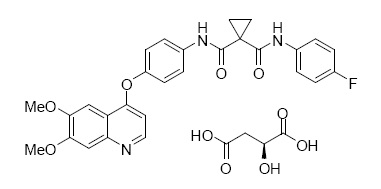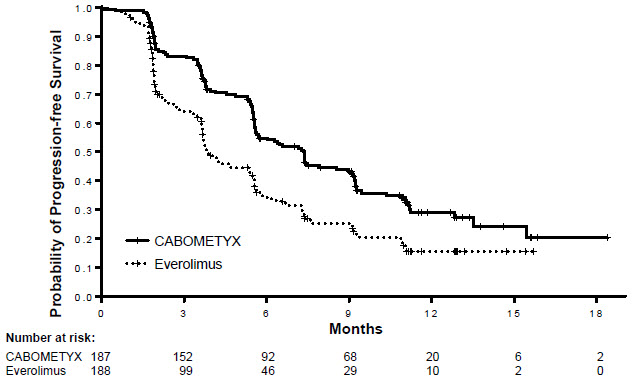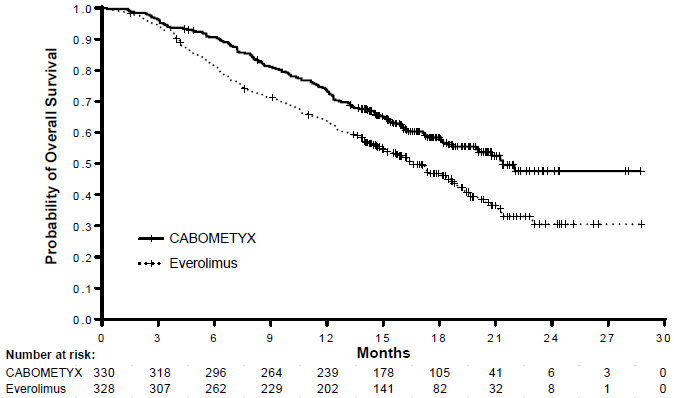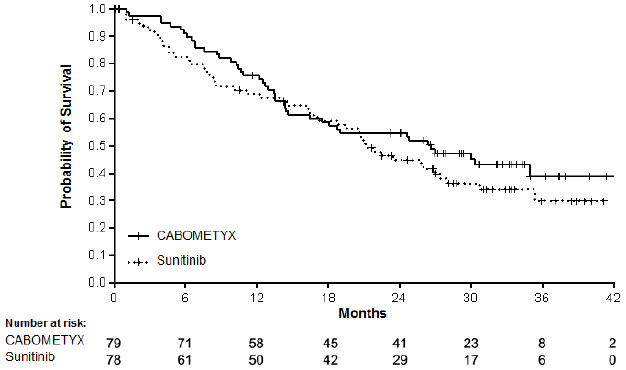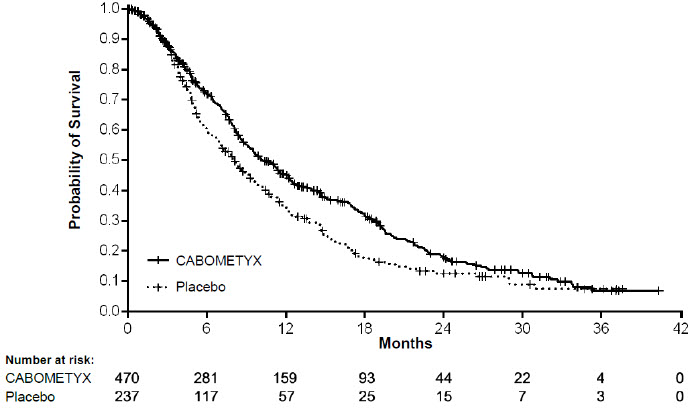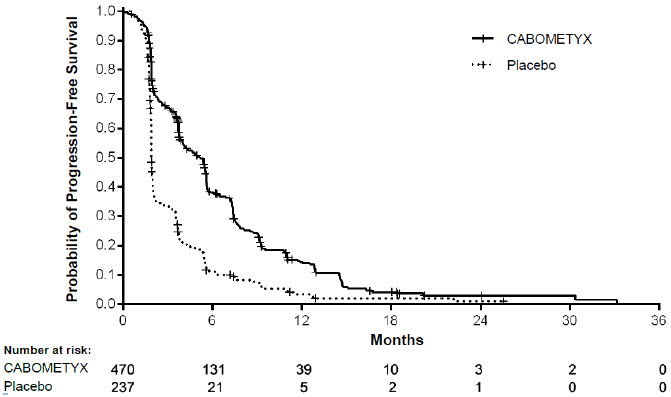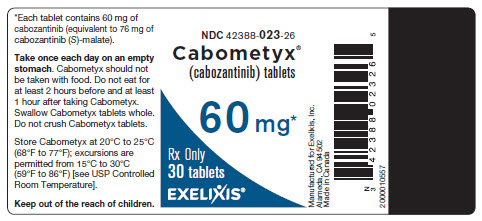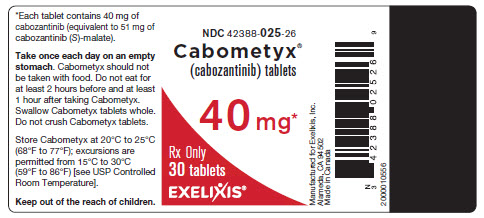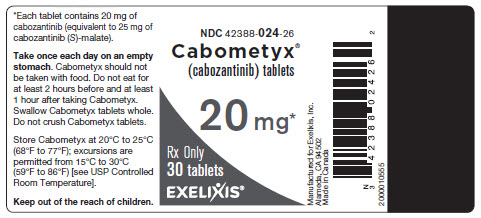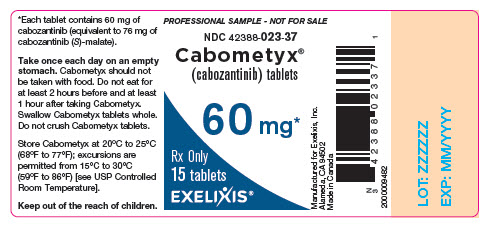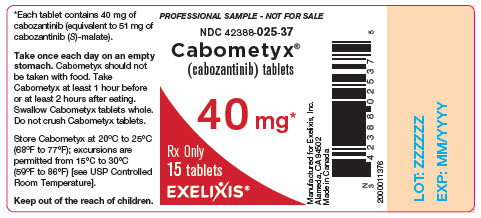CABOMETYX- cabozantinib tablet
CABOMETYX by
Drug Labeling and Warnings
CABOMETYX by is a Prescription medication manufactured, distributed, or labeled by Exelixis, Inc., Patheon Inc., Rottendorf Pharma GmbH. Drug facts, warnings, and ingredients follow.
Drug Details [pdf]
-
HIGHLIGHTS OF PRESCRIBING INFORMATION
These highlights do not include all the information needed to use CABOMETYX safely and effectively. See full prescribing information for CABOMETYX.
CABOMETYX® (cabozantinib) tablets, for oral use
Initial U.S. Approval: 2012RECENT MAJOR CHANGES
Warnings and Precautions, Impaired Wound Healing (5.9) 1/2020
INDICATIONS AND USAGE
DOSAGE AND ADMINISTRATION
DOSAGE FORMS AND STRENGTHS
Tablets: 20 mg, 40 mg, and 60 mg. (3)
CONTRAINDICATIONS
None (4)
WARNINGS AND PRECAUTIONS
- Hemorrhage: Do not administer CABOMETYX if recent history of hemorrhage. (5.1)
- Perforations and Fistulas: Monitor for symptoms. Discontinue CABOMETYX for Grade 4 fistula or perforation. (5.2)
- Thrombotic Events: Discontinue CABOMETYX for myocardial infarction or serious venous or arterial thromboembolic events. (5.3)
- Hypertension and Hypertensive Crisis: Monitor blood pressure regularly. Interrupt for hypertension that is not adequately controlled with anti-hypertensive therapy. Discontinue CABOMETYX for hypertensive crisis or severe hypertension that cannot be controlled with anti-hypertensive therapy. (5.4)
- Diarrhea: May be severe. Interrupt CABOMETYX immediately until diarrhea resolves or decreases to Grade 1. Recommend standard antidiarrheal treatments. (5.5)
- Palmar-Plantar Erythrodysesthesia (PPE): Interrupt CABOMETYX treatment until PPE resolves or decreases to Grade 1. (5.6)
- Proteinuria: Monitor urine protein. Discontinue for nephrotic syndrome. (5.7)
- Osteonecrosis of the jaw (ONJ): Withhold CABOMETYX for at least 3 weeks prior to invasive dental procedures and for development of ONJ. (5.8)
- Impaired Wound Healing: Withhold CABOMETYX for at least 3 weeks before elective surgery. Do not administer for at least 2 weeks following major surgery and adequate wound healing. The safety of resumption of CABOMETYX after resolution of wound healing complications has not been established. (5.9)
- Reversible Posterior Leukoencephalopathy Syndrome (RPLS): Discontinue CABOMETYX. (5.10)
- Embryo-Fetal Toxicity: Can cause fetal harm. Advise females of reproductive potential of the potential risk to a fetus and to use effective contraception. (5.11, 8.1, 8.3)
ADVERSE REACTIONS
The most common (≥ 25%) adverse reactions are: diarrhea, fatigue, decreased appetite, palmar-plantar erythrodysesthesia (PPE), nausea, hypertension, and vomiting. (6.1)
To report SUSPECTED ADVERSE REACTIONS, contact Exelixis, Inc. at 1-855-500-3935 or FDA at 1-800-FDA-1088 or www.fda.gov/medwatch.
DRUG INTERACTIONS
USE IN SPECIFIC POPULATIONS
See 17 for PATIENT COUNSELING INFORMATION and FDA-approved patient labeling.
Revised: 2/2020
-
Table of Contents
FULL PRESCRIBING INFORMATION: CONTENTS*
1 INDICATIONS AND USAGE
1.1 Renal Cell Carcinoma
1.2 Hepatocellular Carcinoma
2 DOSAGE AND ADMINISTRATION
2.1 Important Dosage Information
2.2 Recommended Dosage for Renal Cell Carcinoma
2.3 Recommended Dosage for Hepatocellular Carcinoma
2.4 Dosage Modifications for Adverse Reactions
2.5 Dosage Modifications for Coadministration with Strong CYP3A4 Inhibitors
2.6 Dosage Modifications for Coadministration with Strong CYP3A4 Inducers
2.7 Dosage Modifications for Patients with Moderate and Severe Hepatic Impairment
3 DOSAGE FORMS AND STRENGTHS
4 CONTRAINDICATIONS
5 WARNINGS AND PRECAUTIONS
5.1 Hemorrhage
5.2 Perforations and Fistulas
5.3 Thrombotic Events
5.4 Hypertension and Hypertensive Crisis
5.5 Diarrhea
5.6 Palmar-Plantar Erythrodysesthesia
5.7 Proteinuria
5.8 Osteonecrosis of the Jaw
5.9 Impaired Wound Healing
5.10 Reversible Posterior Leukoencephalopathy Syndrome
5.11 Embryo-Fetal Toxicity
6 ADVERSE REACTIONS
6.1 Clinical Trial Experience
7 DRUG INTERACTIONS
7.1 Effects of Other Drugs on CABOMETYX
8 USE IN SPECIFIC POPULATIONS
8.1 Pregnancy
8.2 Lactation
8.3 Females and Males of Reproductive Potential
8.4 Pediatric Use
8.5 Geriatric Use
8.6 Hepatic Impairment
8.7 Renal Impairment
10 OVERDOSAGE
11 DESCRIPTION
12 CLINICAL PHARMACOLOGY
12.1 Mechanism of Action
12.2 Pharmacodynamics
12.3 Pharmacokinetics
13 NONCLINICAL TOXICOLOGY
13.1 Carcinogenesis, Mutagenesis, Impairment of Fertility
14 CLINICAL STUDIES
14.1 Renal Cell Carcinoma
14.2 Hepatocellular Carcinoma
16 HOW SUPPLIED/STORAGE AND HANDLING
17 PATIENT COUNSELING INFORMATION
- * Sections or subsections omitted from the full prescribing information are not listed.
- 1 INDICATIONS AND USAGE
-
2 DOSAGE AND ADMINISTRATION
2.1 Important Dosage Information
- Stop treatment with CABOMETYX at least 3 weeks prior to scheduled surgery, including dental surgery [see Warnings and Precautions (5.1, 5.8, 5.9)].
- Do not substitute CABOMETYX tablets with cabozantinib capsules.
- Do not administer CABOMETYX with food. Administer at least 1 hour before or at least 2 hours after eating [see Clinical Pharmacology (12.3)].
- Swallow CABOMETYX tablets whole. Do not crush CABOMETYX tablets.
- Do not take a missed dose within 12 hours of the next dose.
- Modify the dose for certain patients with hepatic impairment and for patients taking drugs known to strongly induce or inhibit CYP450 [see Dosage and Administration (2.5, 2.6, 2.7)].
2.2 Recommended Dosage for Renal Cell Carcinoma
The recommended dosage of CABOMETYX is 60 mg once daily without food until the patient no longer experiences clinical benefit or experiences unacceptable toxicity.
2.3 Recommended Dosage for Hepatocellular Carcinoma
The recommended dosage of CABOMETYX is 60 mg once daily without food until disease progression or unacceptable toxicity.
2.4 Dosage Modifications for Adverse Reactions
Withhold CABOMETYX for:
- Intolerable Grade 2 adverse reactions
- Grade 3 or 4 adverse reactions
- Osteonecrosis of the jaw
Upon resolution/improvement (i.e., return to baseline or resolution to Grade 1) of an adverse reaction, reduce the dose as follows:
- If previously receiving 60 mg daily dose, resume treatment at 40 mg daily.
- If previously receiving 40 mg daily dose, resume treatment at 20 mg daily.
- If previously receiving 20 mg daily dose, resume at 20 mg if tolerated, otherwise, discontinue CABOMETYX.
Permanently discontinue CABOMETYX for any of the following:
- Severe hemorrhage
- Development of gastrointestinal (GI) perforation or Grade 4 fistula
- Acute myocardial infarction or arterial or venous thromboembolic events that require medical intervention
- Severe hypertension that cannot be controlled with anti-hypertensive therapy or hypertensive crisis
- Nephrotic syndrome
- Reversible posterior leukoencephalopathy syndrome
2.5 Dosage Modifications for Coadministration with Strong CYP3A4 Inhibitors
Reduce the daily CABOMETYX dose by 20 mg (for example, from 60 mg to 40 mg daily or from 40 mg to 20 mg daily). Resume the dose that was used prior to initiating the strong CYP3A4 inhibitor 2 to 3 days after discontinuation of the strong inhibitor [see Drug Interactions (7.1), Clinical Pharmacology (12.3)].
2.6 Dosage Modifications for Coadministration with Strong CYP3A4 Inducers
Increase the daily CABOMETYX dose by 20 mg (for example, from 60 mg to 80 mg daily or from 40 mg to 60 mg daily) as tolerated. Resume the dose that was used prior to initiating the strong CYP3A4 inducer 2 to 3 days after discontinuation of the strong inducer. Do not exceed a daily dose of 80 mg [see Drug Interactions (7.1), Clinical Pharmacology (12.3)].
2.7 Dosage Modifications for Patients with Moderate and Severe Hepatic Impairment
Reduce the starting dose of CABOMETYX to 40 mg once daily in patients with moderate hepatic impairment (Child-Pugh B). Avoid CABOMETYX in patients with severe hepatic impairment (Child-Pugh C) [see Use in Specific Populations (8.6), Clinical Pharmacology (12.3)].
-
3 DOSAGE FORMS AND STRENGTHS
Tablets:
- 60 mg: yellow film-coated, oval shaped with no score, and debossed with "XL" on one side and "60" on the other side.
- 40 mg: yellow film-coated, triangle shaped with no score, and debossed with "XL" on one side and "40" on the other side.
- 20 mg: yellow film-coated, round with no score, and debossed with "XL" on one side and "20" on the other side.
- 4 CONTRAINDICATIONS
-
5 WARNINGS AND PRECAUTIONS
5.1 Hemorrhage
Severe and fatal hemorrhages occurred with CABOMETYX [see Adverse Reactions (6.1)]. The incidence of Grade 3 to 5 hemorrhagic events was 5% in CABOMETYX-treated patients in RCC and HCC studies.
Discontinue CABOMETYX for Grade 3 or 4 hemorrhage [see Dosage and Administration (2.4)]. Do not administer CABOMETYX to patients who have a recent history of hemorrhage, including hemoptysis, hematemesis, or melena.
5.2 Perforations and Fistulas
Fistulas, including fatal cases, occurred in 1% of CABOMETYX-treated patients [see Adverse Reactions (6.1)]. Gastrointestinal (GI) perforations, including fatal cases, occurred in 1% of CABOMETYX-treated patients.
Monitor patients for signs and symptoms of fistulas and perforations, including abscess and sepsis. Discontinue CABOMETYX in patients who experience a Grade 4 fistula or a GI perforation [see Dosage and Administration (2.4)].
5.3 Thrombotic Events
CABOMETYX increased the risk of thrombotic events [see Adverse Reactions (6.1)]. Venous thromboembolism occurred in 7% (including 4% pulmonary embolism) and arterial thromboembolism occurred in 2% of CABOMETYX-treated patients. Fatal thrombotic events occurred in CABOMETYX-treated patients.
Discontinue CABOMETYX in patients who develop an acute myocardial infarction or serious arterial or venous thromboembolic events that require medical intervention [see Dosage and Administration (2.4)].
5.4 Hypertension and Hypertensive Crisis
CABOMETYX can cause hypertension, including hypertensive crisis [see Adverse Reactions (6.1)]. Hypertension was reported in 36% (17% Grade 3 and <1% Grade 4) of CABOMETYX- treated patients.
Do not initiate CABOMETYX in patients with uncontrolled hypertension. Monitor blood pressure regularly during CABOMETYX treatment. Withhold CABOMETYX for hypertension that is not adequately controlled with medical management; when controlled, resume CABOMETYX at a reduced dose [see Dosage and Administration (2.4)]. Discontinue CABOMETYX for severe hypertension that cannot be controlled with anti-hypertensive therapy or for hypertensive crisis.
5.5 Diarrhea
Diarrhea occurred in 63% of patients treated with CABOMETYX. Grade 3 diarrhea occurred in 11% of patients treated with CABOMETYX [see Adverse Reactions (6.1)].
Withhold CABOMETYX until improvement to Grade 1 and resume CABOMETYX at a reduced dose for intolerable Grade 2 diarrhea, Grade 3 diarrhea that cannot be managed with standard antidiarrheal treatments, or Grade 4 diarrhea [see Dosage and Administration (2.4)].
5.6 Palmar-Plantar Erythrodysesthesia
Palmar-plantar erythrodysesthesia (PPE) occurred in 44% of patients treated with CABOMETYX [see Adverse Reactions (6.1)]. Grade 3 PPE occurred in 13% of patients treated with CABOMETYX.
Withhold CABOMETYX until improvement to Grade 1 and resume CABOMETYX at a reduced dose for intolerable Grade 2 PPE or Grade 3 PPE [see Dosage and Administration (2.4)].
5.7 Proteinuria
Proteinuria was observed in 7% of patients receiving CABOMETYX [see Adverse Reactions (6.1)]. Monitor urine protein regularly during CABOMETYX treatment. Discontinue CABOMETYX in patients who develop nephrotic syndrome [see Dosage and Administration (2.4)].
5.8 Osteonecrosis of the Jaw
Osteonecrosis of the jaw (ONJ) occurred in <1% of patients treated with CABOMETYX [see Adverse Reactions (6.1)]. ONJ can manifest as jaw pain, osteomyelitis, osteitis, bone erosion, tooth or periodontal infection, toothache, gingival ulceration or erosion, persistent jaw pain or slow healing of the mouth or jaw after dental surgery. Perform an oral examination prior to initiation of CABOMETYX and periodically during CABOMETYX. Advise patients regarding good oral hygiene practices. Withhold CABOMETYX for at least 3 weeks prior to scheduled dental surgery or invasive dental procedures, if possible. Withhold CABOMETYX for development of ONJ until complete resolution [see Dosage and Administration (2.1)].
5.9 Impaired Wound Healing
Wound complications occurred with CABOMETYX [see Adverse Reactions (6.1)]. Withhold CABOMETYX for at least 3 weeks prior to elective surgery [see Dosage and Administration (2.1)]. Do not administer CABOMETYX for at least 2 weeks after major surgery and until adequate wound healing. The safety of resumption of CABOMETYX after resolution of wound healing complications has not been established.
5.10 Reversible Posterior Leukoencephalopathy Syndrome
Reversible Posterior Leukoencephalopathy Syndrome (RPLS), a syndrome of subcortical vasogenic edema diagnosed by characteristic finding on MRI, can occur with CABOMETYX. Perform an evaluation for RPLS in any patient presenting with seizures, headache, visual disturbances, confusion or altered mental function. Discontinue CABOMETYX in patients who develop RPLS [see Dosage and Administration (2.4)].
5.11 Embryo-Fetal Toxicity
Based on data from animal studies and its mechanism of action, CABOMETYX can cause fetal harm when administered to a pregnant woman. Cabozantinib administration to pregnant animals during organogenesis resulted in embryolethality at exposures below those occurring clinically at the recommended dose, and in increased incidences of skeletal variations in rats and visceral variations and malformations in rabbits.
Advise pregnant women of the potential risk to a fetus. Advise females of reproductive potential to use effective contraception during treatment with CABOMETYX and for 4 months after the last dose [see Use in Specific Populations (8.1, 8.3), Clinical Pharmacology (12.1)].
-
6 ADVERSE REACTIONS
The following clinically significant adverse reactions are discussed elsewhere in the labeling:
- Hemorrhage [see Warnings and Precautions (5.1)]
- Perforations and Fistulas [see Warnings and Precautions (5.2)]
- Thrombotic Events [see Warnings and Precautions (5.3)]
- Hypertension and Hypertensive Crisis [see Warnings and Precautions (5.4)]
- Diarrhea [see Warnings and Precautions (5.5)]
- Palmar-plantar Erythrodysesthesia [see Warnings and Precautions (5.6)]
- Proteinuria [see Warnings and Precautions (5.7)]
- Osteonecrosis of the Jaw [see Warnings and Precautions (5.8)]
- Impaired Wound Healing [see Warnings and Precautions (5.9)]
- Reversible Posterior Leukoencephalopathy Syndrome [see Warnings and Precautions (5.10)]
6.1 Clinical Trial Experience
The data described in the WARNINGS AND PRECAUTIONS section and below reflect exposure to CABOMETYX as a single agent in 409 patients with RCC enrolled in randomized, active-controlled trials (CABOSUN, METEOR) and 467 patients with HCC enrolled in a randomized, placebo-controlled trial (CELESTIAL).
Because clinical trials are conducted under widely varying conditions, adverse reaction rates observed in the clinical trials of a drug cannot be directly compared to rates in the clinical trials of another drug and may not reflect the rates observed in practice.
Renal Cell Carcinoma
METEOR
The safety of CABOMETYX was evaluated in METEOR, a randomized, open-label trial in which 331 patients with advanced renal cell carcinoma received CABOMETYX 60 mg once daily and 322 patients received everolimus 10 mg once daily until disease progression or unacceptable toxicity. Patients on both arms who had disease progression could continue treatment at the discretion of the investigator [see Clinical Studies (14)]. The median duration of treatment was 7.6 months (range 0.3 – 20.5) for patients receiving CABOMETYX and 4.4 months (range 0.21 – 18.9) for patients receiving everolimus.
Adverse reactions which occurred in ≥ 25% of CABOMETYX-treated patients, in order of decreasing frequency, were: diarrhea, fatigue, nausea, decreased appetite, palmar-plantar erythrodysesthesia (PPE), hypertension, vomiting, weight decreased, and constipation. Grade 3-4 adverse reactions and laboratory abnormalities which occurred in ≥ 5% of patients were hypertension, diarrhea, fatigue, PPE, hyponatremia, hypophosphatemia, hypomagnesemia, lymphopenia, anemia, hypokalemia, and increased GGT.
The dose was reduced in 60% of patients receiving CABOMETYX and in 24% of patients receiving everolimus. Twenty percent (20%) of patients received CABOMETYX 20 mg once daily as their lowest dose. The most frequent adverse reactions leading to dose reduction in patients treated with CABOMETYX were: diarrhea, PPE, fatigue, and hypertension. Adverse reactions leading to dose interruption occurred in 70% patients receiving CABOMETYX and in 59% patients receiving everolimus. Adverse reactions led to study treatment discontinuation in 10% of patients receiving CABOMETYX and in 10% of patients receiving everolimus. The most frequent adverse reactions leading to permanent discontinuation in patients treated with CABOMETYX were decreased appetite (2%) and fatigue (1%).
Table 1. Adverse Reactions Occurring in ≥ 10% Patients Who Received CABOMETYX in METEOR Adverse Reaction CABOMETYX
(n=331)*Everolimus
(n=322)All
Grades†Grades
3-4All
Grades†Grades
3-4Percentage (%) of Patients - * One subject randomized to everolimus received cabozantinib.
- † National Cancer Institute (NCI) Common Terminology Criteria for Adverse Events (CTCAE) Version 4.0
- ‡ Includes the following terms: abdominal pain, abdominal pain upper, and abdominal pain lower
- § Includes the following terms: rash, rash erythematous, rash follicular, rash macular, rash papular, rash pustular, rash vesicular, genital rash, intermittent leg rash, rash on scrotum and penis, rash maculo- papular, rash pruritic, contact dermatitis, dermatitis acneiform
- ¶ Includes the following terms hypertension, blood pressure increased, hypertensive crisis, blood pressure fluctuation
Gastrointestinal Diarrhea 74 11 28 2 Nausea 50 4 28 <1 Vomiting 32 2 14 <1 Stomatitis 22 2 24 2 Constipation 25 <1 19 <1 Abdominal pain‡ 23 4 13 2 Dyspepsia 12 <1 5 0 General Fatigue 56 9 47 7 Mucosal inflammation 19 <1 23 3 Asthenia 19 4 16 2 Metabolism and Nutrition Decreased appetite 46 3 34 <1 Skin and Subcutaneous Tissue Palmar-plantar erythrodysesthesia 42 8 6 <1 Rash§ 23 <1 43 <1 Dry skin 11 0 10 0 Vascular Hypertension¶ 39 16 8 3 Investigations Weight decreased 31 2 12 0 Nervous System Dysgeusia 24 0 9 0 Headache 11 <1 12 <1 Dizziness 11 0 7 0 Endocrine Hypothyroidism 21 0 <1 <1 Respiratory, Thoracic, and Mediastinal Dysphonia 20 <1 4 0 Dyspnea 19 3 29 4 Cough 18 <1 33 <1 Blood and Lymphatic Anemia 17 5 38 16 Musculoskeletal and Connective Tissue Pain in extremity 14 1 8 <1 Muscle spasms 13 0 5 0 Arthralgia 11 <1 14 1 Renal and Urinary Proteinuria 12 2 9 <1 Other clinically important adverse reactions (all grades) that were reported in <10% of patients treated with CABOMETYX included: wound complications (2%), convulsion (<1%), pancreatitis (<1%), osteonecrosis of the jaw (<1%), and hepatitis cholestatic (<1%).
Table 2. Laboratory Abnormalities Occurring in ≥ 25% Patients Who Received CABOMETYX in METEOR Laboratory Abnormality CABOMETYX
(n=331)Everolimus
(n=322)All
GradesGrade 3-4 All
GradesGrade 3-4 Percentage (%) of Patients - * Based on laboratory abnormalities
Chemistry Increased AST 74 3 40 <1 Increased ALT 68 3 32 <1 Increased creatinine 58 <1 71 0 Increased triglycerides 53 4 73 13 Hypophosphatemia 48 8 36 5 Hyperglycemia 37 2 59 8 Hypoalbuminemia 36 2 28 <1 Increased ALP 35 2 29 1 Hypomagnesemia 31 7 4 <1 Hyponatremia 30 8 26 6 Increased GGT 27 5 43 9 Hematology Leukopenia 35 <1 31 <1 Neutropenia 31 2 17 <1 Anemia* 31 4 71 17 Lymphopenia 25 7 39 12 Thrombocytopenia 25 <1 27 <1 ALP, alkaline phosphatase; ALT, alanine aminotransferase; AST, aspartate aminotransferase; GGT, gamma glutamyl transferase. NCI CTCAE, Version 4.0 CABOSUN
The safety of CABOMETYX was evaluated in CABOSUN, a randomized, open-label trial in patients with advanced renal cell carcinoma, in which 78 patients received CABOMETYX 60 mg once daily and 72 patients received sunitinib 50 mg once daily (4 weeks on treatment followed by 2 weeks off), until disease progression or unacceptable toxicity [see Clinical Studies (14.1)]. The median duration of treatment was 6.5 months (range 0.2 – 28.7) for patients receiving CABOMETYX and 3.1 months (range 0.2 – 25.5) for patients receiving sunitinib.
Within 30 days of treatment, there were 4 deaths in patients treated with CABOMETYX and 6 deaths in patients treated with sunitinib. Of the 4 patients treated with CABOMETYX, 2 patients died due to gastrointestinal perforation, 1 patient had acute renal failure, and 1 patient died due to clinical deterioration. All Grade 3-4 adverse reactions were collected in the entire safety population. The most frequent Grade 3-4 adverse reactions (≥5%) in patients treated with CABOMETYX were hypertension, diarrhea, hyponatremia, hypophosphatemia, PPE, fatigue, increased ALT, decreased appetite, stomatitis, pain, hypotension, and syncope.
The median average daily dose was 50.3 mg for CABOMETYX and 44.7 mg for sunitinib (excluding scheduled sunitinib non-dosing days). The dose was reduced in 46% of patients receiving CABOMETYX and in 35% of patients receiving sunitinib. The dose was held in 73% of patients receiving CABOMETYX and in 71% of patients receiving sunitinib. Based on patient disposition, 21% of patients receiving CABOMETYX and 22% of patients receiving sunitinib discontinued due to an adverse reaction.
Table 3. Grade 3-4 Adverse Reactions Occurring in ≥ 1% Patients Who Received CABOMETYX in CABOSUN Adverse Reaction CABOMETYX
(n = 78)Sunitinib
(n = 72)Grade 3-4* Grade 3-4* Percentage (%) of Patients Patients with any Grade 3-4 Adverse Reaction 68 65 - * NCI CTCAE Version 4.0
- † Laboratory abnormalities are reported as adverse reactions and not based on shifts in laboratory values
- ‡ ncludes the following term: hypertension
Gastrointestinal Diarrhea 10 11 Stomatitis 5 6 Nausea 3 4 Vomiting 1 3 Constipation 1 0 General Fatigue 6 17 Pain 5 0 Metabolism and Nutrition Hyponatremia† 9 8 Hypophosphatemia† 9 7 Decreased appetite 5 1 Dehydration 4 1 Hypocalcemia† 3 0 Hypomagnesemia† 3 0 Hypokalemia† 1 3 Skin and Subcutaneous Tissue Palmar-plantar erythrodysesthesia 8 4 Skin Ulcer 3 0 Vascular Hypertension‡ 28 21 Hypotension 5 1 Angiopathy 1 1 Investigations Increased ALT† 5 0 Weight decreased 4 0 Increased AST† 3 3 Increased blood creatinine† 3 3 Lymphopenia† 1 6 Thrombocytopenia† 1 11 Nervous System Syncope 5 0 Respiratory, Thoracic, and Mediastinal Dyspnea 1 6 Dysphonia 1 0 Blood and Lymphatic Anemia 1 3 Psychiatric Depression 4 0 Confusional state 1 1 Infections Lung Infection 4 0 Musculoskelatal and Connective Tissue Back pain 4 0 Bone pain 3 1 Pain in extremity 3 0 Arthralgia 1 0 Renal and Urinary Renal failure acute 4 1 Proteinuria 3 1 ALT, alanine aminotransferase; AST, aspartate aminotransferase Hepatocellular Carcinoma
The safety of CABOMETYX was evaluated in CELESTIAL, a randomized, double-blind, placebo-controlled trial in which 704 patients with advanced hepatocellular carcinoma were randomized to receive CABOMETYX 60 mg orally once daily (n=467) or placebo (n=237) until disease progression or unacceptable toxicity [see Clinical Studies (14.2)]. The median duration of treatment was 3.8 months (range 0.1 – 37.3) for patients receiving CABOMETYX and 2.0 months (range 0.0 – 27.2) for patients receiving placebo. The population exposed to CABOMETYX was 81% male, 56% White, and had a median age of 64 years.
Adverse reactions occurring in ≥ 25% of CABOMETYX-treated patients, in order of decreasing frequency were: diarrhea, decreased appetite, PPE, fatigue, nausea, hypertension, and vomiting. Grade 3-4 adverse reactions which occurred in ≥ 5% of patients were PPE, hypertension, fatigue, diarrhea, asthenia, and decreased appetite. There were 6 adverse reactions leading to death in patients receiving CABOMETYX (hepatic failure, hepatorenal syndrome, esophagobronchial fistula, portal vein thrombosis, pulmonary embolism, upper gastrointestinal hemorrhage).
The median average daily dose was 35.8 mg for CABOMETYX. The dose was reduced in 62% of patients receiving CABOMETYX; 33% of patients required a reduction to 20 mg daily. The most frequent adverse reactions or laboratory abnormalities leading to dose reduction of CABOMETYX were: PPE, diarrhea, fatigue, hypertension, and increased AST. Adverse reactions leading to dose interruption occurred in 84% patients receiving CABOMETYX. Adverse reactions leading to permanent discontinuation of CABOMETYX occurred in 16% of patients. The most frequent adverse reactions leading to permanent discontinuation of CABOMETYX were PPE (2%), fatigue (2%), decreased appetite (1%), diarrhea (1%), and nausea (1%).
Table 4. Adverse Reactions Occurring in ≥ 5% of CABOMETYX-Treated Patients in CELESTIAL* Adverse Reaction CABOMETYX
(n=467)Placebo
(n=237)All Grades† Grade 3-4 All Grades† Grade 3-4 Percentage (%) of Patients - * Includes terms with a between-arm difference of ≥ 5% (all grades) or ≥ 2% (Grade 3-4)
- † NCI CTCAE Version 4.0
- ‡ Includes the following terms: rash, rash erythematous, rash generalized, rash macular, rash maculo- papular, rash papular, rash pruritic, rash pustular, rash vesicular, dermatitis, dermatitis acneiform, dermatitis contact, dermatitis diaper, dermatitis exfoliative, dermatitis infected
- § Includes the following terms: hypertension, blood pressure diastolic increased, blood pressure increased
Gastrointestinal Diarrhea 54 10 19 2 Nausea 31 2 18 2 Vomiting 26 <1 12 3 Stomatitis 13 2 2 0 Dyspepsia 10 0 3 0 General Fatigue 45 10 30 4 Asthenia 22 7 8 2 Mucosal inflammation 14 2 2 <1 Metabolism and Nutrition Decreased appetite 48 6 18 <1 Skin and Subcutaneous Tissue Palmar-plantar erythrodysesthesia 46 17 5 0 Rash‡ 21 2 9 <1 Vascular Hypertension§ 30 16 6 2 Investigations Weight decreased 17 1 6 0 Nervous System Dysgeusia 12 0 2 0 Endocrine Hypothyroidism 8 <1 <1 0 Respiratory, Thoracic, and Mediastinal Dysphonia 19 1 2 0 Dyspnea 12 3 10 <1 Musculoskeletal and Connective Tissue Pain in extremity 9 <1 4 1 Muscle spasms 8 <1 2 0 Table 5. Laboratory Abnormalities Occurring in ≥ 5% of CABOMETYX-Treated Patients in CELESTIAL* Laboratory Abnormality CABOMETYX
(n=467)Placebo
(n=237)All Grades Grade 3-4 All Grades Grade 3-4 Percentage (%) of Patients - * Includes laboratory abnormalities with a between-arm difference of ≥ 5% (all grades) or ≥ 2% (Grade 3-4)
Chemistry Increased LDH 84 9 29 2 Increased ALT 73 12 37 6 Increased AST 73 24 46 19 Hypoalbuminemia 51 1 32 1 Increased ALP 43 8 38 6 Hypophosphatemia 25 9 8 4 Hypokalemia 23 6 6 1 Hypomagnesemia 22 3 3 0 Increased amylase 16 2 9 2 Hypocalcemia 8 2 0 0 Hematology Decreased platelets 54 10 16 1 Neutropenia 43 7 8 1 Increased hemoglobin 8 0 1 0 ALP, alkaline phosphatase; ALT, alanine aminotransferase; AST, aspartate aminotransferase; LDH, blood lactate dehydrogenase -
7 DRUG INTERACTIONS
7.1 Effects of Other Drugs on CABOMETYX
Strong CYP3A4 Inhibitors
Coadministration of a cabozantinib capsule formulation with a strong CYP3A4 inhibitor increased the exposure of cabozantinib, which may increase the risk of exposure-related adverse reactions [see Clinical Pharmacology (12.3)]. Avoid coadministration of CABOMETYX with strong CYP3A4 inhibitors. Reduce the dosage of CABOMETYX if coadministration with strong CYP3A4 inhibitors cannot be avoided [see Dosage and Administration (2.5)]. Avoid grapefruit or grapefruit juice which may also increase exposure of cabozantinib.
Strong CYP3A Inducers
Coadministration of a cabozantinib capsule formulation with a strong CYP3A4 inducer decreased the exposure of cabozantinib, which may reduce efficacy [see Clinical Pharmacology (12.3)]. Avoid coadministration of CABOMETYX with strong CYP3A4 inducers. Increase the dosage of CABOMETYX if coadministration with strong CYP3A4 inducers cannot be avoided [see Dosage and Administration (2.6)]. Avoid St. John’s wort which may also decrease exposure of cabozantinib.
-
8 USE IN SPECIFIC POPULATIONS
8.1 Pregnancy
Risk Summary
Based on findings from animal studies and its mechanism of action [see Clinical Pharmacology (12.1)], CABOMETYX can cause fetal harm when administered to a pregnant woman. There are no available data in pregnant women to inform the drug-associated risk. In animal developmental and reproductive toxicology studies administration of cabozantinib to pregnant rats and rabbits during organogenesis resulted in embryofetal lethality and structural anomalies at exposures that were below those occurring clinically at the recommended dose (see Data). Advise pregnant women of the potential risk to a fetus.
In the U.S. general population, the estimated background risk of major birth defects and miscarriage in clinically recognized pregnancies is 2-4% and 15-20%, respectively.
Animal Data
In an embryo-fetal development study in pregnant rats, daily oral administration of cabozantinib throughout organogenesis caused increased embryo-fetal lethality compared to controls at a dose of 0.03 mg/kg (approximately 0.12-fold of human area under the curve [AUC] at the recommended dose). Findings included delayed ossification and skeletal variations at a dose of 0.01 mg/kg/day (approximately 0.04-fold of human AUC at the recommended dose).
In pregnant rabbits, daily oral administration of cabozantinib throughout organogenesis resulted in findings of visceral malformations and variations including reduced spleen size and missing lung lobe at 3 mg/kg (approximately 1.1-fold of the human AUC at the recommended dose).
In a pre- and postnatal study in rats, cabozantinib was administered orally from gestation day 10 through postnatal day 20. Cabozantinib did not produce adverse maternal toxicity or affect pregnancy, parturition or lactation of female rats, and did not affect the survival, growth or postnatal development of the offspring at doses up to 0.3 mg/kg/day (0.05-fold of the maximum recommended clinical dose).
8.2 Lactation
Risk Summary
There is no information regarding the presence of cabozantinib or its metabolites in human milk, or their effects on the breastfed child or milk production. Because of the potential for serious adverse reactions in breastfed children, advise women not to breastfeed during treatment with CABOMETYX and for 4 months after the final dose.
8.3 Females and Males of Reproductive Potential
Pregnancy Testing
Verify the pregnancy status of females of reproductive potential prior to initiating CABOMETYX [see Use in Specific Populations (8.1)].
Contraception
CABOMETYX can cause fetal harm when administered to a pregnant woman [see Use in Specific Populations (8.1)].
Females
Advise females of reproductive potential to use effective contraception during treatment with CABOMETYX and for 4 months after the final dose.
Infertility
Females and Males
Based on findings in animals, CABOMETYX may impair fertility in females and males of reproductive potential [see Nonclinical Toxicology (13.1)].
8.4 Pediatric Use
The safety and effectiveness of CABOMETYX in pediatric patients have not been established.
Juvenile Animal Toxicity Data
Juvenile rats were administered cabozantinib at doses of 1 or 2 mg/kg/day from Postnatal Day 12 (comparable to less than 2 years in humans) through Postnatal Day 35 or 70. Mortalities occurred at doses ≥1 mg/kg/day (approximately 0.16 times the clinical dose of 60 mg/day based on body surface area). Hypoactivity was observed at both doses tested on Postnatal Day 22. Targets were generally similar to those seen in adult animals, occurred at both doses, and included the kidney (nephropathy, glomerulonephritis), reproductive organs, gastrointestinal tract (cystic dilatation and hyperplasia in Brunner’s gland and inflammation of duodenum; and epithelial hyperplasia of colon and cecum), bone marrow (hypocellularity and lymphoid depletion), and liver. Tooth abnormalities and whitening as well as effects on bones including reduced bone mineral content and density, physeal hypertrophy, and decreased cortical bone also occurred at all dose levels. Recovery was not assessed at a dose of 2 mg/kg (approximately 0.32 times the clinical dose of 60 mg based on body surface area) due to high levels of mortality. At the low dose level, effects on bone parameters were partially resolved but effects on the kidney and epididymis/testis persisted after treatment ceased.
8.5 Geriatric Use
In CABOSUN and METEOR, 41% of 409 patients treated with CABOMETYX were age 65 years and older, and 8% were 75 years and older. In CELESTIAL, 49% of 467 patients treated with CABOMETYX were age 65 years and older, and 15% were 75 years and older.
No overall differences in safety or effectiveness were observed between these patients and younger patients.
8.6 Hepatic Impairment
Increased exposure to cabozantinib has been observed in patients with moderate (Child-Pugh B) hepatic impairment. Reduce the CABOMETYX dose in patients with moderate hepatic impairment. Avoid CABOMETYX in patients with severe hepatic impairment (Child-Pugh C), since it has not been studied in this population [see Dosage and Administration (2.7), Clinical Pharmacology (12.3)].
8.7 Renal Impairment
No dosage adjustment is recommended in patients with mild or moderate renal impairment. There is no experience with CABOMETYX in patients with severe renal impairment [see Clinical Pharmacology (12.3)].
-
10 OVERDOSAGE
One case of overdosage was reported following administration of another formulation of cabozantinib; a patient inadvertently took twice the intended dose for 9 days. The patient suffered Grade 3 memory impairment, Grade 3 mental status changes, Grade 3 cognitive disturbance, Grade 2 weight loss, and Grade 1 increase in BUN. The extent of recovery was not documented.
-
11 DESCRIPTION
CABOMETYX is the (S)-malate salt of cabozantinib, a kinase inhibitor. Cabozantinib (S)-malate is described chemically as N-(4-(6,7-dimethoxyquinolin-4-yloxy)phenyl)-N'-(4-fluorophenyl)cyclopropane-1,1-dicarboxamide, (2S)-hydroxybutanedioate. The molecular formula is C28H24FN3O5C4H6O5 and the molecular weight is 635.6 Daltons as malate salt. The chemical structure of cabozantinib (S)-malate salt is:
Cabozantinib (S)-malate salt is a white to off-white solid that is practically insoluble in aqueous media.
CABOMETYX (cabozantinib) tablets for oral use are supplied as film-coated tablets containing 20 mg, 40 mg, or 60 mg of cabozantinib, which is equivalent to 25 mg, 51 mg, or 76 mg of cabozantinib (S)-malate, respectively. CABOMETYX also contains the following inactive ingredients: microcrystalline cellulose, lactose anhydrous, hydroxypropyl cellulose, croscarmellose sodium, colloidal silicon dioxide, and magnesium stearate.
The film coating contains hypromellose, titanium dioxide, triacetin, and iron oxide yellow.
-
12 CLINICAL PHARMACOLOGY
12.1 Mechanism of Action
In vitro biochemical and/or cellular assays have shown that cabozantinib inhibits the tyrosine kinase activity of MET, VEGFR-1, -2 and -3, AXL, RET, ROS1, TYRO3, MER, KIT, TRKB, FLT-3, and TIE-2. These receptor tyrosine kinases are involved in both normal cellular function and pathologic processes such as oncogenesis, metastasis, tumor angiogenesis, drug resistance, and maintenance of the tumor microenvironment.
12.2 Pharmacodynamics
The exposure-response or –safety relationship for cabozantinib is unknown.
Cardiac Electrophysiology
The effect of cabozantinib on QTc interval was evaluated in a randomized, double-blinded, placebo-controlled trial in patients with medullary thyroid cancer administered a cabozantinib capsule formulation. A mean increase in QTcF of 10 - 15 ms was observed at 4 weeks after initiation. A concentration-QTc relationship could not be definitively established. Changes in cardiac wave form morphology or new rhythms were not observed. No patients in this study had a confirmed QTcF > 500 ms nor did any patients in METEOR, CABOSUN, or CELESTIAL.
12.3 Pharmacokinetics
Repeat daily dosing of a cabozantinib capsule formulation for 19 days resulted in 4- to 5-fold mean cabozantinib accumulation (based on AUC) compared to a single dose administration; steady state was achieved by Day 15.
Absorption
Median time to peak cabozantinib concentrations (Tmax) ranged from 3 to 4 hours post-dose. A 19% increase in the Cmax of CABOMETYX compared to a cabozantinib capsule formulation was observed following a single 140 mg dose. A less than 10% difference in the AUC was observed between CABOMETYX and a cabozantinib capsule formulation [see Dosage and Administration (2.1)].
Food Effect
Cabozantinib Cmax and AUC increased by 41% and 57%, respectively, following a high-fat meal relative to fasted conditions in healthy subjects administered a single oral dose of a cabozantinib capsule formulation.
Distribution
The oral volume of distribution (Vz/F) of cabozantinib is approximately 319 L. Cabozantinib is highly protein bound in human plasma (≥ 99.7%).
Elimination
The predicted terminal half-life is approximately 99 hours and the clearance (CL/F) at steady-state is estimated to be 2.2 L/hr.
Metabolism
Cabozantinib is a substrate of CYP3A4 in vitro.
Excretion
Approximately 81% of the total administered radioactivity was recovered within a 48-day collection period following a single dose of radiolabeled 14C-cabozantinib in healthy subjects. Approximately 54% was recovered in feces and 27% in urine. Unchanged cabozantinib accounted for 43% of the total radioactivity in feces and was not detectable in urine following a 72-hour collection.
Specific Populations
The following patient characteristics did not result in a clinically relevant difference in the pharmacokinetics of cabozantinib: age (32-86 years), sex, race (Whites and non-Whites), or mild to moderate renal impairment (eGFR ≥ 30 mL/min/1.73 m2 as estimated by MDRD (modification of diet in renal disease equation)). The pharmacokinetics of cabozantinib is unknown in patients with eGFR < 29 mL/min/1.73m2 as estimated by MDRD equation or requiring dialysis.
Patients with Hepatic Impairment
Based on a population pharmacokinetic analysis of cabozantinib in healthy subjects and patients with cancer, no clinically significant differences in the mean cabozantinib exposure were observed between subjects with normal liver function (total bilirubin and AST ≤ ULN) and those with mild hepatic impairment (total bilirubin ≤ ULN and AST > ULN or total bilirubin > 1 to 1.5x ULN and any AST value). In a dedicated pharmacokinetic study, cabozantinib exposure (AUC0-INF) increased by 63% in patients with moderate hepatic impairment (Child-Pugh B). Patients with severe hepatic impairment have not been studied [see Dosage and Administration (2.7), Use in Specific Populations (8.6)].
Drug Interaction Studies
Clinical Studies
CYP3A4 Inhibitors:
Administration of a strong CYP3A4 inhibitor, ketoconazole (400 mg daily for 27 days), with a cabozantinib capsule formulation to healthy subjects increased single-dose cabozantinib exposure (AUC0-INF) by 38%.
CYP3A4 Inducers:
Administration of a strong CYP3A4 inducer, rifampin (600 mg daily for 31 days), with a cabozantinib capsule formulation to healthy subjects decreased single-dose cabozantinib exposure (AUC0-INF) by 77%.
CYP2C8 Substrates:
No clinically-significant effect on single-dose rosiglitazone (a CYP2C8 substrate) exposure (Cmax and AUC) was observed when co-administered with a cabozantinib capsule formulation at steady-state concentrations.
Gastric Acid Reducing Agents:
No clinically-significant effect on cabozantinib exposure (AUC) was observed following co- administration of the proton pump inhibitor (PPI) esomeprazole (40 mg daily for 6 days) with a single 100 mg dose of a cabozantinib capsule formulation to healthy subjects.
In vitro Studies
CYP Enzymes:
Inhibition of CYP3A4 reduced the formation of the oxidative metabolite by > 80%. Inhibition of CYP2C9 had a minimal effect on cabozantinib metabolite formation (i.e., a <20% reduction). Inhibition of CYP1A2, CYP2A6, CYP2B6, CYP2C8, CYP2C19, CYP2D6 and CYP2E1 had no effect on cabozantinib metabolite formation.
Although cabozantinib is an inhibitor of CYP2C8 in vitro, a clinical study of this potential interaction concluded that concurrent use did not result in a clinically relevant effect on CYP2C8 substrate exposure. Given this finding, other less sensitive substrates of pathways affected by cabozantinib in vitro (i.e., CYP2C9, CYP2C19, and CYP3A4) were not evaluated in a clinical study, because, although a clinically relevant exposure effect cannot be ruled out, it is unlikely. Cabozantinib does not inhibit CYP1A2 and CYP2D6 isozymes in vitro.
Cabozantinib is an inducer of CYP1A1 mRNA; however, the clinical relevance of this finding is unknown. Cabozantinib does not induce CYP1A2, CYP2B6, CYP2C8, CYP2C9, CYP2C19 or CYP3A4.
Transporters:
Cabozantinib is an inhibitor, but not a substrate, of P-gp transport activities and has the potential to increase concentrations of co-administered substrates of P-gp. The clinical relevance of this finding is unknown.
Cabozantinib is a substrate of MRP2 in vitro and MRP2 inhibitors have the potential to increase concentrations of cabozantinib. The clinical relevance of this finding is unknown.
-
13 NONCLINICAL TOXICOLOGY
13.1 Carcinogenesis, Mutagenesis, Impairment of Fertility
The carcinogenic potential of cabozantinib has been evaluated in two species: rasH2 transgenic mice and Sprague-Dawley rats. In the 2-year rat carcinogenicity study, once daily oral administration of cabozantinib resulted in a statistically significant increase in the incidence of malignant/complex malignant pheochromocytoma in combination with benign pheochromocytoma or in benign pheochromocytoma alone in male rats at a dose of 1 mg/kg (approximately 5 times the human exposure by AUC at the recommended 60 mg dose). Cabozantinib was not carcinogenic in a 26-week carcinogenicity study in rasH2 transgenic mice at a slightly higher exposure than the intended human therapeutic exposure.
Cabozantinib was not mutagenic in vitro in the bacterial reverse mutation (Ames) assay and was not clastogenic in both the in vitro cytogenetic assay using human lymphocytes or in the in vivo mouse micronucleus assay.
Based on nonclinical findings, male and female fertility may be impaired by treatment with CABOMETYX. In a fertility study in which cabozantinib was administered to male and female rats at doses of 1, 2.5, and 5 mg/kg/day, male fertility was significantly compromised at doses equal to or greater than 2.5 mg/kg/day (approximately 13-fold of human AUC at the recommended dose), with a decrease in sperm counts and reproductive organ weights. In females, fertility was significantly reduced at doses equal to or greater than 1 mg/kg/day (5-fold of human AUC at the recommended dose) with a significant decrease in the number of live embryos and a significant increase in pre- and post-implantation losses.
Observations of effects on reproductive tract tissues in general toxicology studies were supportive of effects noted in the dedicated fertility study and included hypospermia and absence of corpora lutea in male and female dogs in a 6-month repeat dose study at plasma exposures (AUC) approximately 0.5-fold (males) and <0.1-fold (females) of those expected in humans at the recommended dose. In addition, female rats administered 5 mg/kg/day for 14 days (approximately 9-fold of human AUC at the recommended dose) exhibited ovarian necrosis.
-
14 CLINICAL STUDIES
14.1 Renal Cell Carcinoma
Previously Treated with Anti-angiogenic Therapy
The efficacy of CABOMETYX was evaluated in METEOR (NCT01865747), a randomized (1:1), open-label, multicenter trial of CABOMETYX versus everolimus conducted in patients with advanced RCC who had received at least 1 prior anti-angiogenic therapy. Patients had to have a Karnofsky Performance Score (KPS) ≥ 70%. Patients were stratified by the number of prior VEGFR tyrosine kinase inhibitors (TKIs) and Memorial Sloan Kettering Cancer Center (MSKCC) Risk Group.
Patients were randomized to receive CABOMETYX (N=330) 60 mg orally once daily or everolimus (N=328) 10 mg orally once daily. The majority of the patients were male (75%), with a median age of 62 years. Sixty-nine percent (69%) received only one prior anti-angiogenic therapy. Patient distribution by MSKCC risk groups was 46% favorable (0 risk factors), 42% intermediate (1 risk factor), and 13% poor (2 or 3 risk factors). Fifty-four percent (54%) of patients had 3 or more organs with metastatic disease, including lung (63%), lymph nodes (62%), liver (29%), and bone (22%).
The main efficacy outcome measure was progression-free survival (PFS) assessed by a blinded independent radiology review committee among the first 375 subjects randomized. Other efficacy endpoints were objective response rate (ORR) and overall survival (OS) in the Intent-to- Treat (ITT) population. Tumor assessments were conducted every 8 weeks for the first 12 months, then every 12 weeks thereafter. Patients received treatment until disease progression or experiencing unacceptable toxicity. Patients on both arms who had disease progression could continue treatment at the discretion of the investigator.
Statistically significant improvements in PFS, OS, and ORR were demonstrated for CABOMETYX compared to everolimus. Efficacy results are presented in Tables 6 and 7 and Figures 1 and 2.
Table 6: Efficacy Results in METEOR (First 375 Randomized) Endpoint CABOMETYX Everolimus N = 187 N = 188 - * stratified log-rank test with prior VEGFR-targeting TKI therapy (1 vs 2 or more) and MSKCC prognostic criteria for previously treated patients with RCC (0 vs 1 vs 2 or 3) as stratification factors (per IVRS data)
Median PFS (95% CI), months 7.4 (5.6, 9.1) 3.8 (3.7, 5.4) HR (95% CI), p-value* 0.58 (0.45, 0.74), p<0.0001
Figure 1: Kaplan-Meier Curves of Progression-Free Survival in METEOR (First 375 Randomized)
Table 7: Efficacy Results in METEOR (ITT) Endpoint CABOMETYX Everolimus N = 330 N = 328 - * stratified log-rank test with prior VEGFR-targeting TKI therapy (1 vs 2 or more) and MSKCC prognostic criteria for previously treated patients with RCC (0 vs 1 vs 2 or 3) as stratification factors (per IVRS data)
- † chi-squared test
Median OS (95% CI), months 21.4 (18.7, NE) 16.5 (14.7, 18.8) HR (95% CI), p-value* 0.66 (0.53, 0.83), p=0.0003 Confirmed ORR (partial responses only) (95% CI) 17% (13%, 22%) 3% (2%, 6%) p-value† p<0.0001
Figure 2: Kaplan-Meier Curve of Overall Survival in METEOR (ITT)
First-line Treatment
The efficacy of CABOMETYX was evaluated in CABOSUN (NCT01835158), a randomized (1:1), open-label, multicenter trial of CABOMETYX versus sunitinib conducted in patients with advanced RCC who had not received prior therapy. Patients were randomized to receive CABOMETYX (N=79) 60 mg orally once daily or sunitinib (N=78) 50 mg orally once daily (4 weeks on treatment followed by 2 weeks off) until disease progression or unacceptable toxicity. All patients were required to have intermediate or poor risk disease as defined by the International Metastatic RCC Database Consortium (IMDC) risk group categories. Patients were stratified by IMDC risk group and presence of bone metastases (yes/no).
The majority of patients were male (78%), with a median age of 63 years. Patient distribution by IMDC risk groups was 81% intermediate (1-2 risk factors) and 19% poor (≥3 risk factors). Thirty-six percent (36%) patients had bone metastases. Forty-six percent (46%) of patients were ECOG 0, 41% ECOG 1, and 13% ECOG 2.
The major efficacy outcome measure was progression-free survival (PFS) by a retrospective blinded independent radiology review committee (BIRC).
A statistically significant improvement in PFS, as assessed by a blinded independent radiology review committee, was demonstrated for CABOMETYX compared to sunitinib. Efficacy results are presented in Table 8, Figure 3, and Figure 4.
Table 8: Efficacy Results in CABOSUN Endpoint CABOMETYX Sunitinib N = 79 N = 78 Progression-Free Survival* - * as assessed by a retrospective blinded independent radiology review committee (BIRC)
- † estimated from stratified Cox proportional hazards model with stratification factors IMDC risk group and presence of bone metastases and treatment as covariate
- ‡ two-sided stratified log-rank test with stratification factors IMDC risk group and presence of bone metastases
- § no multiplicity adjustments were made for overall survival or ORR
Events, n(%) 43 (54) 49 (63) Median PFS (95% CI), months* 8.6 (6.8, 14.0) 5.3 (3.0, 8.2) Hazard Ratio† (95% CI), p-value‡ 0.48 (0.31, 0.74), p=0.0008 Overall Survival Events, n(%) 43 (54) 47 (60) Hazard Ratio†, § (95% CI) 0.80 (0.53, 1.21) Confirmed ORR, partial responses only (95% CI)*, § 20% (12.0, 30.8) 9% (3.7, 17.6)
Figure 3: Kaplan-Meier Curve of Progression-Free Survival in CABOSUN
Figure 4: Kaplan-Meier Curve of Overall Survival in CABOSUN
14.2 Hepatocellular Carcinoma
The efficacy of CABOMETYX was evaluated in CELESTIAL (NCT01908426), a randomized (2:1), double-blind, placebo-controlled, multicenter trial in patients with hepatocellular carcinoma (HCC) who had previously received sorafenib and had Child Pugh Class A liver impairment. Patients were randomized to receive CABOMETYX 60 mg orally once daily or placebo until disease progression or unacceptable toxicity. Randomization was stratified by etiology of disease (hepatitis B virus [HBV] with or without hepatitis C virus [HCV] vs. HCV [without HBV] vs. other [without HBV and HCV]), geographic region (Asia vs. other regions), and presence of extrahepatic spread of disease and/or macrovascular invasion (yes vs. no). The primary efficacy outcome measure was overall survival (OS). Additional outcome measures were progression-free survival (PFS) and objective response rate (ORR), as assessed by investigators per RECIST 1.1. Tumor assessments were conducted every 8 weeks.
In CELESTIAL, a total of 707 patients were randomized, 470 to CABOMETYX and 237 to placebo. The median age was 64 years (range 22 to 86 years), 82% were male, 56% were White and 34% were Asian. Baseline ECOG performance status was 0 (53%) or 1 (47%). The etiology of HCC was attributed to HBV in 38% of patients and HCV in 21%; etiology was attributed to causes other than HBV or HCV in 40%. Macroscopic vascular invasion or extra-hepatic tumor spread was present in 78% of patients and 41% had alpha-fetoprotein (AFP) levels ≥ 400 mcg/L. All patients received prior sorafenib and 27% received two prior systemic therapy regimens.
Efficacy results are summarized in Table 9, Figure 5, and Figure 6.
Table 9: Efficacy Results from CELESTIAL Endpoint CABOMETYX Placebo N = 470 N = 237 Overall Survival - * estimated using the Cox proportional-hazard model
- † log-rank test stratified by etiology of disease (HBV [with or without HCV], HCV [without HBV], or Other), geographic region (Asia, Other Regions), and presence of extrahepatic spread of disease and/or macrovascular invasion (Yes, No) as stratification factors (per IVRS data)
- ‡ significance level = 0.021 for 78% information (484 deaths) based on O’Brien-Fleming method
- § Fisher’s exact test
Number of Deaths, (%) 317 (67) 167 (70) Median OS in Months (95% CI) 10.2 (9.1, 12.0) 8.0 (6.8, 9.4) Hazard Ratio (95% CI)* 0.76 (0.63, 0.92) p-value† p=0.0049‡ Progression-Free Survival Number of Events, (%) 349 (74) 205 (86) Progressive Disease 284 (60) 186 (78) Death 65 (14) 19 (8) Median PFS in Months (95% CI) 5.2 (4.0, 5.5) 1.9 (1.9, 1.9) Hazard Ratio (95% CI)* 0.44 (0.36, 0.52) p-value† p< 0.0001 Overall Response Rate (ORR) Confirmed ORR (partial responses only) (95% CI)‡ 4% (2.3, 6.0) 0.4% (0.0, 2.3) p-value§ p=0.0086
Figure 5: Kaplan-Meier Curve of Overall Survival in CELESTIAL
Figure 6: Kaplan-Meier Curve of Progression-Free Survival in CELESTIAL
-
16 HOW SUPPLIED/STORAGE AND HANDLING
CABOMETYX tablets are supplied as follows:
60 mg tables are yellow film-coated, oval shaped with no score, debossed with "XL" on one side and "60" on the other side of the tablet; available in bottles of 30 tablets:
NDC: 42388-023-2640 mg tablets are yellow film-coated, triangle shaped with no score, debossed with "XL" on one side and "40" on the other side of the tablet; available in bottles of 30 tablets:
NDC: 42388-025-2620 mg tablets are yellow film-coated, round shaped with no score, debossed with "XL" on one side and "20" on the other side of the tablet; available in bottles of 30 tablets:
NDC: 42388-024-26Store CABOMETYX at 20°C to 25°C (68°F to 77°F); excursions are permitted from 15°C to 30°C (59°F to 86°F) [see USP Controlled Room Temperature].
-
17 PATIENT COUNSELING INFORMATION
Advise the patient to read the FDA-approved patient labeling (Patient Information).
- Hemorrhage: Instruct patients to contact their healthcare provider to seek immediate medical attention for signs or symptoms of unusual severe bleeding or hemorrhage [see Warnings and Precautions (5.1)].
- Perforations and fistulas: Advise patients that gastrointestinal disorders such as diarrhea, nausea, vomiting, and constipation may develop during CABOMETYX treatment and to seek immediate medical attention if they experience persistent or severe abdominal pain because cases of gastrointestinal perforation and fistula have been reported in patients taking CABOMETYX [see Warnings and Precautions (5.2)].
- Thrombotic Events: Venous and arterial thrombotic events have been reported. Advise patients to report signs or symptoms of an arterial thrombosis. Venous thromboembolic events including pulmonary embolus have been reported. Advise patients to contact their health care provider if new onset of dyspnea, chest pain, or localized limb edema occurs [see Warnings and Precautions (5.3)].
- Hypertension and hypertensive crisis: Inform patients of the signs and symptoms of hypertension. Advise patients to undergo routine blood pressure monitoring and to contact their health care provider if blood pressure is elevated or if they experience signs or symptoms of hypertension [see Warnings and Precautions (5.4)].
- Diarrhea: Advise patients to notify their healthcare provider at the first signs of poorly formed or loose stool or an increased frequency of bowel movements [see Warnings and Precautions (5.5)].
- Palmar-plantar erythrodysesthesia: Advise patients to contact their healthcare provider for progressive or intolerable rash [see Warnings and Precautions (5.6)].
- Osteonecrosis of the jaw: Advise patients regarding good oral hygiene practices. Advise patients to immediately contact their healthcare provider for signs or symptoms associated with osteonecrosis of the jaw [see Warnings and Precautions (5.8)].
- Impaired wound healing: Advise patients that CABOMETYX may impair wound healing. Advise patients to inform their healthcare provider of any planned surgical procedure [see Dosage and Administration (2.1), Warnings and Precautions (5.9)].
- Reversible posterior leukoencephalopathy syndrome: Advise patients to immediately contact their health care provider for new onset or worsening neurological function [see Warnings and Precautions (5.10)].
-
Embryo-fetal toxicity:
- Advise females of reproductive potential of the potential risk to a fetus. Advise females to inform their healthcare provider of a known or suspected pregnancy [see Warnings and Precautions (5.11), Use in Specific Populations (8.1)].
- Advise females of reproductive potential to use effective contraception during treatment with CABOMETYX and for 4 months after the final dose [Use in Specific Populations (8.3)].
- Lactation: Advise women not to breastfeed during treatment with CABOMETYX and for 4 months following the last dose [Use in Specific Populations (8.2)].
- Drug interactions: Advise patients to inform their healthcare provider of all prescription or nonprescription medications, vitamins or herbal products. Inform patients to avoid grapefruit, grapefruit juice, and St. John’s wort [see Drug Interactions (7.1)].
Important administration information
- Instruct patients to take CABOMETYX at least 1 hour before or at least 2 hours after eating.
Manufactured for Exelixis, Inc. Alameda, CA 94502
-
PATIENT PACKAGE INSERT
PATIENT INFORMATION
CABOMETYX® (Ka-boe-met-iks)
cabozantinib
tabletsWhat is CABOMETYX?
CABOMETYX is a prescription medicine used to treat people with:- advanced kidney cancer (renal cell carcinoma)
- liver cancer (hepatocellular carcinoma) who have been previously treated with the medicine sorafenib.
Before you take CABOMETYX, tell your healthcare provider about all of your medical conditions, including if you: - have a recent history of bleeding, including coughing up or vomiting blood, or black tarry stools.
- have an open or healing wound
- have high blood pressure
- plan to have any surgery, dental procedure, or have had a recent surgery. You should stop taking CABOMETYX at least 3 weeks before planned surgery. See "What are the possible side effects of CABOMETYX?"
- are pregnant, or plan to become pregnant. CABOMETYX can harm your unborn baby.
- If you are able to become pregnant, your healthcare provider will check your pregnancy status before you start treatment with CABOMETYX.
- Females who are able to become pregnant should use effective birth control (contraception) during treatment and for 4 months after your final dose of CABOMETYX.
- Talk to your healthcare provider about birth control methods that may be right for you.
- If you become pregnant or think you are pregnant, tell your healthcare provider right away.
- are breastfeeding or plan to breastfeed. It is not known if CABOMETYX passes into your breast milk. Do not breastfeed during treatment and for 4 months after your final dose of CABOMETYX.
How should I take CABOMETYX? - Take CABOMETYX exactly as your healthcare provider tells you to take it.
- Do not take CABOMETYX with food. Take CABOMETYX at least 1 hour before or at least 2 hours after eating.
- Swallow CABOMETYX tablets whole with a full glass (at least 8 ounces) of water.
- Do not crush CABOMETYX tablets.
- If you miss a dose and your next dose is in:
- less than 12 hours, take your next dose at the normal time. Do not make up the missed dose.
- 12 hours or more, take the missed dose as soon as you remember. Take your next dose at the normal time.
What should I avoid while taking CABOMETYX?
Do not drink grapefruit juice, eat grapefruit or take supplements that contain grapefruit or St. John’s wort during treatment with CABOMETYX.What are the possible side effects of CABOMETYX?
CABOMETYX may cause serious side effects, including:-
bleeding (hemorrhage). CABOMETYX can cause severe bleeding that may lead to death. Tell your healthcare provider right away if you get any signs of bleeding during treatment with CABOMETYX, including:
- coughing up blood or blood clots
- vomiting blood or if your vomit looks like coffee-grounds
- red or black (looks like tar) stools
- menstrual bleeding that is heavier than normal
- any unusual or heavy bleeding
- a tear in your stomach or intestinal wall (perforation) or an abnormal connection between 2 parts of your body (fistula). Tell your healthcare provider right away if you get tenderness or pain in your stomach-area (abdomen).
-
blood clots, stroke, heart attack, and chest pain. Get emergency help right away if you get:
- swelling or pain in your arms or legs
- shortness of breath
- feel lightheaded or faint
- sweating more than usual
- numbness or weakness of your face, arm or leg, especially on one side of your body
- sudden confusion, trouble speaking or understanding
- sudden trouble seeing in one or both eyes
- sudden trouble walking
- dizziness, loss of balance or coordination
- a sudden severe headache
- diarrhea. Diarrhea is common with CABOMETYX and can be severe. If needed, your healthcare provider may prescribe medicine to treat your diarrhea. Tell your healthcare provider right away, if you have frequent loose, watery bowel movements.
- a skin problem called hand-foot skin reaction. Hand-foot skin reactions are common and can be severe. Tell your healthcare provider right away if you have rashes, redness, pain, swelling, or blisters on the palms of your hands or soles of your feet.
- protein in your urine and possible kidney problems. Symptoms may include swelling in your hands, arms, legs, or feet.
- severe jaw bone problems (osteonecrosis). Symptoms may include jaw pain, toothache, or sores on your gums. Your healthcare provider should examine your mouth before you start and during treatment with CABOMETYX. Tell your dentist that you are taking CABOMETYX. It is important for you to practice good mouth care during treatment with CABOMETYX.
-
wound healing problems. Wound healing problems have happened in some people who take CABOMETYX. Tell your healthcare provider if you plan to have any surgery before or during treatment with CABOMETYX.
- You should stop taking CABOMETYX at least 3 weeks before planned surgery.
- Your healthcare provider should tell you when you may start taking CABOMETYX again after surgery.
- Reversible Posterior Leukoencephalopathy Syndrome (RPLS). A condition called reversible posterior leukoencephalopathy syndrome can happen during treatment with CABOMETYX. Tell your healthcare provider right away if you have headaches, seizures, confusion, changes in vision, or problems thinking.
- CABOMETYX may cause fertility problems in females and males, which may affect your ability to have children. Talk to your healthcare provider if you have concerns about fertility.
The most common side effects of CABOMETYX include:- tiredness
- decreased appetite
- weight loss
- nausea
- vomiting
- changes in certain blood tests
Tell your healthcare provider if you have any side effect that bothers you or that does not go away. These are not all of the possible side effects of CABOMETYX. Call your doctor for medical advice about side effects. You may report side effects to FDA at 1-800-FDA-1088.How should I store CABOMETYX? - Store CABOMETYX at room temperature 68°F to 77°F (20°C to 25°C).
General information about the safe and effective use of CABOMETYX.
Medicines are sometimes prescribed for purposes other than those listed in a Patient Information leaflet. Do not use CABOMETYX for a condition for which it was not prescribed. Do not give CABOMETYX to other people, even if they have the same symptoms you have. It may harm them.
You can ask your healthcare provider or pharmacist for information about CABOMETYX that is written for health professionals.What are the ingredients in CABOMETYX?
Active ingredient: cabozantinib
Inactive ingredients: microcrystalline cellulose, lactose anhydrous, hydroxypropyl cellulose, croscarmellose sodium, colloidal silicon dioxide, and magnesium stearate. The film coating contains hypromellose, titanium dioxide, triacetin, and iron oxide yellow.
Manufactured for Exelixis, Inc. Alameda, CA 94502
For more information, go to www.cabometyx.com or call 1-855-292-3935.This Patient Information has been approved by the U.S. Food and Drug Administration. Issued: 01/2020 -
PRINCIPAL DISPLAY PANEL
Package Label - Bottle - 30 Tablets - 60mg CABOMETYXPRINCIPAL DISPLAY PANEL
NDC 42388-023-26
Cabometyx®
(cabozantinib) tablets
60 mg*Rx Only
30 tablets
Exelixis®*Each tablet contains 60 mg of
cabozantinib (equivalent to 76 mg of
cabozantinib (S)-malate).Take once each day on an empty
stomach. Cabometyx should not
be taken with food. Take
Cabometyx at least 1 hour before
or at least 2 hours after eating.
Swallow Cabometyx tablets whole.
Do not crush Cabometyx tablets.Store Cabometyx at 20°C to 25°C
(68°F to 77°F); excursions are
permitted from 15°C to 30°C
(59°F to 86°F) [see USP Controlled
Room Temperature].Keep out of the reach of children.
Manufactured for Exelixis, Inc.
Alameda, CA 94502
Made in Canada -
PRINCIPAL DISPLAY PANEL
Package Label - Bottle - 30 Tablets - 40mg CABOMETYXPRINCIPAL DISPLAY PANEL
NDC 42388-025-26
Cabometyx®
(cabozantinib) tablets
40 mg*Rx Only
30 tablets
Exelixis®*Each tablet contains 40 mg of
cabozantinib (equivalent to 51 mg of
cabozantinib (S)-malate).Take once each day on an empty
stomach. Cabometyx should not
be taken with food. Take
Cabometyx at least 1 hour before
or at least 2 hours after eating.
Swallow Cabometyx tablets whole.
Do not crush Cabometyx tablets.Store Cabometyx at 20°C to 25°C
(68°F to 77°F); excursions are
permitted from 15°C to 30°C
(59°F to 86°F) [see USP Controlled
Room Temperature].Keep out of the reach of children.
Manufactured for Exelixis, Inc.
Alameda, CA 94502
Made in Canada -
PRINCIPAL DISPLAY PANEL
Package Label - Bottle - 30 Tablets - 20mg CABOMETYXPRINCIPAL DISPLAY PANEL
NDC 42388-024-26
Cabometyx®
(cabozantinib) tablets
20 mg*Rx Only
30 tablets
Exelixis®*Each tablet contains 20 mg of
cabozantinib (equivalent to 25 mg of
cabozantinib (S)-malate).Take once each day on an empty
stomach. Cabometyx should not
be taken with food. Take
Cabometyx at least 1 hour before
or at least 2 hours after eating.
Swallow Cabometyx tablets whole.
Do not crush Cabometyx tablets.Store Cabometyx at 20°C to 25°C
(68°F to 77°F); excursions are
permitted from 15°C to 30°C
(59°F to 86°F) [see USP Controlled
Room Temperature].Keep out of the reach of children.
Manufactured for Exelixis, Inc.
Alameda, CA 94502
Made in Canada -
PRINCIPAL DISPLAY PANEL
Package Label - Professional Sample - Bottle - 15 Tablets - 60mg CABOMETYXPRINCIPAL DISPLAY PANEL
PROFESSIONAL SAMPLE - NOT FOR SALE
NDC 42388-023-37
Cabometyx®
(cabozantinib) tablets
60 mg*Rx Only
15 tablets
Exelixis®*Each tablet contains 60 mg of
cabozantinib (equivalent to 76 mg of
cabozantinib (S)-malate).Take once each day on an empty
stomach. Cabometyx should not
be taken with food. Take
Cabometyx at least 1 hour before
or at least 2 hours after eating.
Swallow Cabometyx tablets whole.
Do not crush Cabometyx tablets.Store Cabometyx at 20°C to 25°C
(68°F to 77°F); excursions are
permitted from 15°C to 30°C
(59°F to 86°F) [see USP Controlled
Room Temperature].Keep out of the reach of children.
Manufactured for Exelixis, Inc.
Alameda, CA 94502
Made in Canada -
PRINCIPAL DISPLAY PANEL
Package Label - Professional Sample - Bottle - 15 Tablets - 40mg CABOMETYXPRINCIPAL DISPLAY PANEL
PROFESSIONAL SAMPLE - NOT FOR SALE
NDC 42388-025-37
Cabometyx®
(cabozantinib) tablets
40 mg*Rx Only
15 tablets
Exelixis®*Each tablet contains 40 mg of
cabozantinib (equivalent to 51 mg of
cabozantinib (S)-malate).Take once each day on an empty
stomach. Cabometyx should not
be taken with food. Take
Cabometyx at least 1 hour before
or at least 2 hours after eating.
Swallow Cabometyx tablets whole.
Do not crush Cabometyx tablets.Store Cabometyx at 20°C to 25°C
(68°F to 77°F); excursions are
permitted from 15°C to 30°C
(59°F to 86°F) [see USP Controlled
Room Temperature].Keep out of the reach of children.
Manufactured for Exelixis, Inc.
Alameda, CA 94502
Made in Canada -
PRINCIPAL DISPLAY PANEL
Package Label - Professional Sample - Bottle - 15 Tablets - 20mg CABOMETYXPRINCIPAL DISPLAY PANEL
PROFESSIONAL SAMPLE - NOT FOR SALE
NDC 42388-024-37
Cabometyx®
(cabozantinib) tablets
20 mg*Rx Only
15 tablets
Exelixis®*Each tablet contains 20 mg of
cabozantinib (equivalent to 25 mg of
cabozantinib (S)-malate).Take once each day on an empty
stomach. Cabometyx should not
be taken with food. Take
Cabometyx at least 1 hour before
or at least 2 hours after eating.
Swallow Cabometyx tablets whole.
Do not crush Cabometyx tablets.Store Cabometyx at 20°C to 25°C
(68°F to 77°F); excursions are
permitted from 15°C to 30°C
(59°F to 86°F) [see USP Controlled
Room Temperature].Keep out of the reach of children.
Manufactured for Exelixis, Inc.
Alameda, CA 94502
Made in Canada -
INGREDIENTS AND APPEARANCE
CABOMETYX
cabozantinib tabletProduct Information Product Type HUMAN PRESCRIPTION DRUG Item Code (Source) NDC: 42388-023 Route of Administration ORAL Active Ingredient/Active Moiety Ingredient Name Basis of Strength Strength cabozantinib s-malate (UNII: DR7ST46X58) (CABOZANTINIB - UNII:1C39JW444G) CABOZANTINIB 60 mg Inactive Ingredients Ingredient Name Strength CELLULOSE, MICROCRYSTALLINE (UNII: OP1R32D61U) ANHYDROUS LACTOSE (UNII: 3SY5LH9PMK) HYDROXYPROPYL CELLULOSE (1600000 WAMW) (UNII: RFW2ET671P) CROSCARMELLOSE SODIUM (UNII: M28OL1HH48) SILICON DIOXIDE (UNII: ETJ7Z6XBU4) MAGNESIUM STEARATE (UNII: 70097M6I30) HYPROMELLOSES (UNII: 3NXW29V3WO) TITANIUM DIOXIDE (UNII: 15FIX9V2JP) TRIACETIN (UNII: XHX3C3X673) FERRIC OXIDE YELLOW (UNII: EX438O2MRT) Product Characteristics Color yellow Score no score Shape OVAL Size 11mm Flavor Imprint Code XL;60 Contains Packaging # Item Code Package Description Marketing Start Date Marketing End Date 1 NDC: 42388-023-26 30 in 1 BOTTLE; Type 0: Not a Combination Product 04/25/2016 2 NDC: 42388-023-36 30 in 1 BOTTLE; Type 0: Not a Combination Product 11/16/2017 3 NDC: 42388-023-37 15 in 1 BOTTLE; Type 0: Not a Combination Product 10/03/2018 Marketing Information Marketing Category Application Number or Monograph Citation Marketing Start Date Marketing End Date NDA NDA208692 04/25/2016 CABOMETYX
cabozantinib tabletProduct Information Product Type HUMAN PRESCRIPTION DRUG Item Code (Source) NDC: 42388-025 Route of Administration ORAL Active Ingredient/Active Moiety Ingredient Name Basis of Strength Strength cabozantinib s-malate (UNII: DR7ST46X58) (CABOZANTINIB - UNII:1C39JW444G) CABOZANTINIB 40 mg Inactive Ingredients Ingredient Name Strength CELLULOSE, MICROCRYSTALLINE (UNII: OP1R32D61U) ANHYDROUS LACTOSE (UNII: 3SY5LH9PMK) HYDROXYPROPYL CELLULOSE (1600000 WAMW) (UNII: RFW2ET671P) CROSCARMELLOSE SODIUM (UNII: M28OL1HH48) SILICON DIOXIDE (UNII: ETJ7Z6XBU4) MAGNESIUM STEARATE (UNII: 70097M6I30) HYPROMELLOSES (UNII: 3NXW29V3WO) TITANIUM DIOXIDE (UNII: 15FIX9V2JP) TRIACETIN (UNII: XHX3C3X673) FERRIC OXIDE YELLOW (UNII: EX438O2MRT) Product Characteristics Color yellow Score no score Shape TRIANGLE Size 8mm Flavor Imprint Code XL;40 Contains Packaging # Item Code Package Description Marketing Start Date Marketing End Date 1 NDC: 42388-025-26 30 in 1 BOTTLE; Type 0: Not a Combination Product 04/25/2016 2 NDC: 42388-025-37 15 in 1 BOTTLE; Type 0: Not a Combination Product 02/27/2019 Marketing Information Marketing Category Application Number or Monograph Citation Marketing Start Date Marketing End Date NDA NDA208692 04/25/2016 CABOMETYX
cabozantinib tabletProduct Information Product Type HUMAN PRESCRIPTION DRUG Item Code (Source) NDC: 42388-024 Route of Administration ORAL Active Ingredient/Active Moiety Ingredient Name Basis of Strength Strength cabozantinib s-malate (UNII: DR7ST46X58) (CABOZANTINIB - UNII:1C39JW444G) CABOZANTINIB 20 mg Inactive Ingredients Ingredient Name Strength CELLULOSE, MICROCRYSTALLINE (UNII: OP1R32D61U) ANHYDROUS LACTOSE (UNII: 3SY5LH9PMK) HYDROXYPROPYL CELLULOSE (1600000 WAMW) (UNII: RFW2ET671P) CROSCARMELLOSE SODIUM (UNII: M28OL1HH48) SILICON DIOXIDE (UNII: ETJ7Z6XBU4) MAGNESIUM STEARATE (UNII: 70097M6I30) HYPROMELLOSES (UNII: 3NXW29V3WO) TITANIUM DIOXIDE (UNII: 15FIX9V2JP) TRIACETIN (UNII: XHX3C3X673) FERRIC OXIDE YELLOW (UNII: EX438O2MRT) Product Characteristics Color yellow Score no score Shape ROUND Size 6mm Flavor Imprint Code XL;20 Contains Packaging # Item Code Package Description Marketing Start Date Marketing End Date 1 NDC: 42388-024-26 30 in 1 BOTTLE; Type 0: Not a Combination Product 04/25/2016 2 NDC: 42388-024-37 15 in 1 BOTTLE; Type 0: Not a Combination Product 02/27/2019 Marketing Information Marketing Category Application Number or Monograph Citation Marketing Start Date Marketing End Date NDA NDA208692 04/25/2016 Labeler - Exelixis, Inc. (785991949) Registrant - Exelixis, Inc. (785991949) Establishment Name Address ID/FEI Business Operations Patheon Inc. 240769596 manufacture(42388-023, 42388-024, 42388-025)
Trademark Results [CABOMETYX]
Mark Image Registration | Serial | Company Trademark Application Date |
|---|---|
 CABOMETYX 86927889 not registered Live/Pending |
Exelixis, Inc. 2016-03-03 |
 CABOMETYX 86621339 5105828 Live/Registered |
Exelixis, Inc. 2015-05-06 |
 CABOMETYX 86471554 not registered Dead/Abandoned |
Exelixis, Inc. 2014-12-04 |
 CABOMETYX 85331905 not registered Dead/Abandoned |
Exelixis, Inc. 2011-05-26 |
 CABOMETYX 85331904 not registered Dead/Abandoned |
Exelixis, Inc. 2011-05-26 |
© 2025 FDA.report
This site is not affiliated with or endorsed by the FDA.
